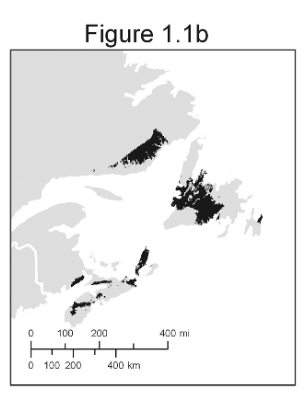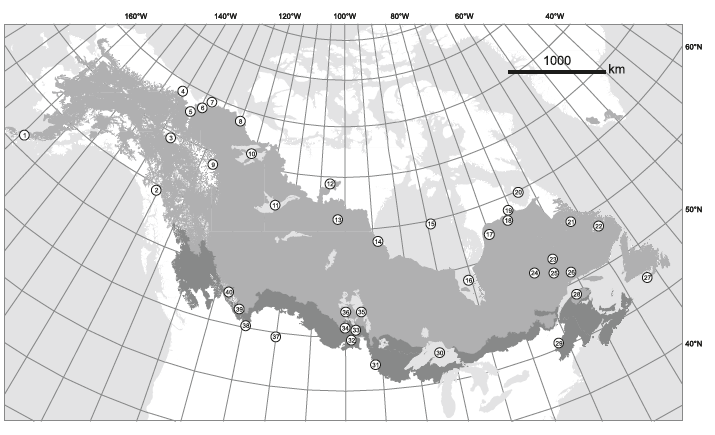‘Workin on it
The brown text is taken from Wikipedia: Forest dynamics, as it is a fairly clear and concise description of forest dynamics; bolding is mine.
Contents
FOREST DISTURBANCES
*COMMENT ON THE BOREAL RAINFORESTS
**COMMENT ON NATURAL DISTURBANCES IN CANADA’S BOREAL FOREST
FOREST SUCCESSION
Cited Lit (Wikipedia)
NDR Lit&Links (Separate Page)
Forest dynamics describes the underlying physical and biological forces that shape and change a forest ecosystem. The continuous state of change in forests can be summarized with two basic elements: disturbance and succession.
FOREST DISTURBANCES
Forest disturbances are events that cause change in the structure and composition of a forest ecosystem, beyond the growth and death of individual organisms.
Disturbances can vary in frequency and intensity, and include natural disasters such as fire, landslides, wind, volcanic eruptions, rare meteor impacts, outbreaks of insects, fungi, and other pathogens, animal-caused effects such as grazing and trampling, and anthropogenic disturbances such as warfare, logging, pollution, the clearing of land for urbanization or agriculture, and the introduction of invasive species.
Not all disturbances are destructive or negative to the overall forest ecosystem. Many natural disturbances allow for renewal and growth and often release necessary nutrients.[1]
Small-scale disturbances are the key to creating and maintaining diversity and heterogeneity within a forest. Small-scale disturbances are events such as single-tree blowdowns, which create gaps that let light through the canopy to the understory and forest floor. This available light allows early-successional shade-intolerant species to colonize and maintain a population within the dominant forest, leading to the complex spatial mosaic forest structure recognized as old-growth. This process is referred to as patch dynamics or gap dynamics and has been described across many types of forests, including tropical, temperate, and boreal.[2]
Comment: Gap dynamics are thought by most researchers to be the predominant type of disturbance in the New England-Acadian Forest Region (view, for example,
SEYMOUR, R.S. 2005. Integrating disturbance parameters into conventional silvicultural systems: Experience from the Acadian forest of northeastern North America. P. 41- 48 in Balancing ecosystem values: Innovative experiments for sustainable forestry, Peterson, C.E., and D.A. Maguire (eds.). US For. Serv. Gen. Tech. Rep. PNW-GTR-635. 389 p.41-48.)
The sets and patterns of natural disturbances that characterize a particular area or ecosystem are referred to as the ecosystem’s disturbance regime. A natural community is closely linked with its natural disturbance regime.[3]
For example, temperate and boreal rainforests* typically have a disturbance regime consisting of high-frequency but small-scale events, resulting in a highly complex forest dominated by very old trees.[4]
In contrast, forests that have a disturbance regime consisting of high-severity stand-replacing events, such as frequent fires [e.g., as over most of Canada’s boreal forest] tend to be more uniform in structure and have relatively young tree stands.**
*COMMENT ON THE BOREAL RAINFORESTS
 Climate suitable for temperate and boreal rainforests – Eastern Canada, from DellaSala D.A., Alaback P., Spribille T., von Wehrden H., Nauman R.S. (2011) Just What Are Temperate and Boreal Rainforests?. In: Temperate and Boreal Rainforests of the World: Ecology and Conservation. Island Press, Washington, DC. https://doi.org/10.5822/978-1-61091-008-8_1 The boreal rainforests, as defined by DellaSalla et al., 2011 occur over a very restricted portion of the boreal zone, where otherwise “high-severity stand-replacing events, such as frequent fires” are the more common disturbance regimes. DellaSalla: “these [boreal rainforests] include the Pacific Coast of North America north of ~55°N latitude (chapter 2), the northern half of the inland rainforest of Northwestern NorthAmerica (chapter 3), much of the wet forests of Eastern Canada (chapter 4)”. The “wet forests of Eastern Canada” include significant portions of the NS landscape, view Dellasalla et al., 2011, Fig 1.1b and Fig 1-6, and Claydon et al., 2011. Also: Canada’s other rainforest. NS does not lie within the boreal zone but does occur within the “hemiboreal” subzone “which is a transitional area lying immediately to the south of the boreal zone that is usually included in the boreal zone by Europeans but excluded by North Americans” (Brandt, 2009), i.e. North Americans generally do not use the term “hemiboreal”, but just consider it to be part of the temperate zone. Claydon et al., 2011 (chapter 4 in DellaSala, D.A. (Editor, 2011) describe in some detail the “Perhumid” Hemiboreal Forests of Eastern Canada, in which NS figures prominently. Based on the lichen communities, it is argued the Perihumid Hemiboreal forests [or at least a portion of them] should be regarded as true rainforests.
One of those indicator lichens is boreal felt lichen Clayden S.R., Cameron R.P., McCarthy J.W. (2011) Perhumid Boreal and Hemiboreal Forests of Eastern Canada. In: Temperate and Boreal Rainforests of the World: Ecology and Conservation. Island Press, Washington, DC. https://doi.org/10.5822/978-1-61091-008-8_4 DellaSala D.A., Alaback P., Spribille T., von Wehrden H., Nauman R.S. (2011) Just What Are Temperate and Boreal Rainforests?. In: Temperate and Boreal Rainforests of the World: Ecology and Conservation. Island Press, Washington, DC. https://doi.org/10.5822/978-1-61091-008-8_1 DellaSala, D.A. (Editor, 2011) Temperate and Boreal Rainforests of the World: Ecology and Conservation. Island Press, Washington, DC https://doi.org/10.5822/978-1-61091-008-8 View TOC (11 chapters) |
| **COMMENT ON NATURAL DISTURBANCES IN CANADA’S BOREAL FOREST
Over most of the boreal forest in Canada, a disturbance regime “consisting of high-severity stand-replacing events” (above) predominates, with fire and insects being the major agents of disturbance. Harvesting is predominantly by clearcutting.
An introduction to Canada’s boreal zone: ecosystem processes, health, sustainability, and environmental issues Natural Disturbances in Canada’s Boreal Forest (Video) Harvesting the Boreal Forest (Video) Natural disturbance emulation in boreal forest ecosystem management — theories, strategies, and a comparison with conventional even-aged management Forest Management Guide for Natural Disturbance Pattern Emulation Version 3.1 |
FOREST SUCCESSION
Forest succession is the process by which species recover and regenerate after a disturbance. The type of disturbance, the climate and weather conditions, the presence of colonizing species, and the interactions among species all influence the path that succession will take. Species diversity and composition fluctuate throughout succession. The classic model of succession is known as relay floristics and refers to a relay of dominant species. After a stand-replacing disturbance, shade-intolerant species colonize and grow into a dominant canopy, but due to their shade-intolerance they are unable to regenerate under their own canopy; the understory (composed of shade-tolerant species) gradually replaces the canopy, and due to its shade-tolerance it can regenerate under its own canopy and therefore becomes the dominant species.[5] Often succession is not so complete or directed as the relay floristics model describes. Species can be mid-tolerant of shade and survive by taking advantage of small amounts of light coming through the canopy, and further disturbances can create small gaps. These and other factors can lead to a mixture of dominant species and a not so obvious “end” to succession (climax community).[6]
Many successional trajectories follow a basic four-stage development pattern.
The first of these stages, stand initiation, occurs after a major disturbance and involves many species arriving in the area of abundant light and nutrients.
The second stage, stem exclusion, describes the growth and competition of these species as resources become less available; likely one or a few species outcompetes and becomes stand-dominating.
The third stage, understory reinitiation, involves further disturbance and the creation of gaps; at this point stratification develops, with layers of canopy, midstory, and understory appearing.
The final stage, known as old-growth, is the extension and completion of the understory reinititation; a complex multi-aged and multi-layered forest has developed.[7]
Cited Lit (Wikipedia)
1. Binelli, Eliana Kampf; Gholz, Henry L.; Duryea, Mary L. “Chapter 4: Plant Succession and Disturbances in the Urban Forest Ecosystem”. University of Florida, IFAS Extension.
2. Yamamoto, Shin-Ichi (2000). “Forest Gap Dynamics and Tree Regeneration”. J. For. Res. 5: 223–229. doi:10.1007/bf02767114
3. Stone, Emily; Menendez, Lydia (20 October 2011). “Natural Disturbance Regime*“. The Encyclopedia of Earth. Retrieved 26 November 2014.
4. DellaSala, Dominick A.[Editor] (2011). Temperate and Boreal Rainforests of The World: Ecology and Conservation. Island Press. pp. 32–34. Read Ch 1 here
5. Approaches to Ecological Based Forest Management on Private Lands* USFS and University of Minnesota Extension Service. Retrieved 26 November 2014.
6. Approaches to Ecological Based Forest Management on Private Lands* USFS and University of Minnesota Extension Service. Retrieved 26 November 2014.
7. Baker, Jim; Hunter, Charles (8 December 2013). “Ecological Basis of Silviculture“. Southern Forest Resource Assessment. Retrieved 26 November 2014.

